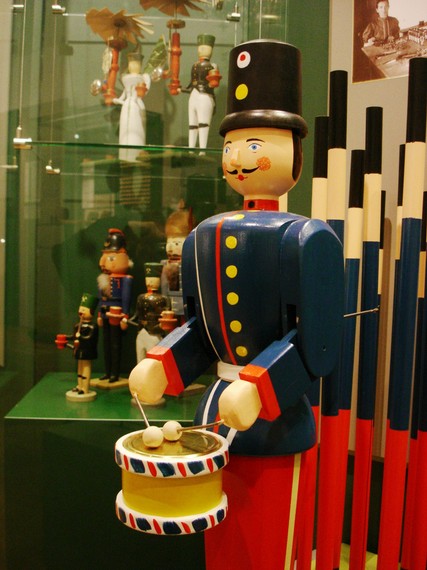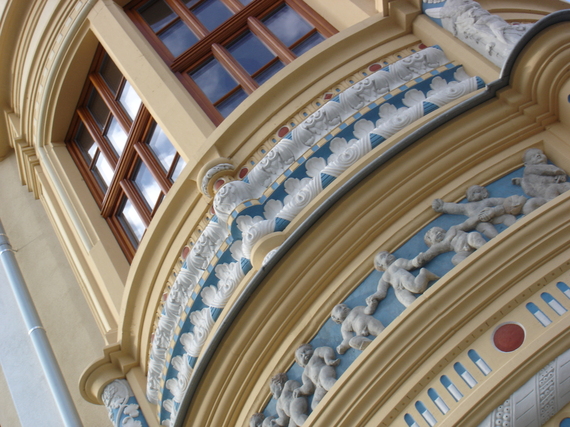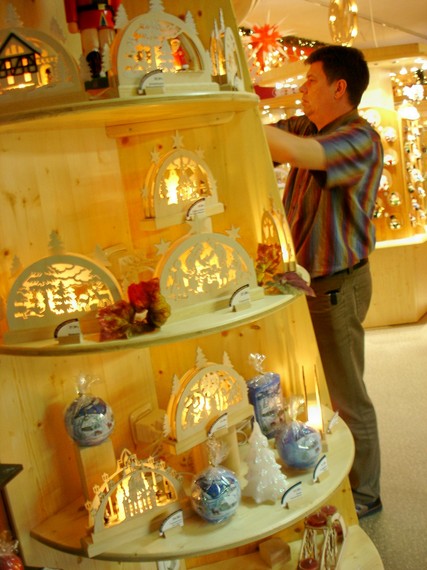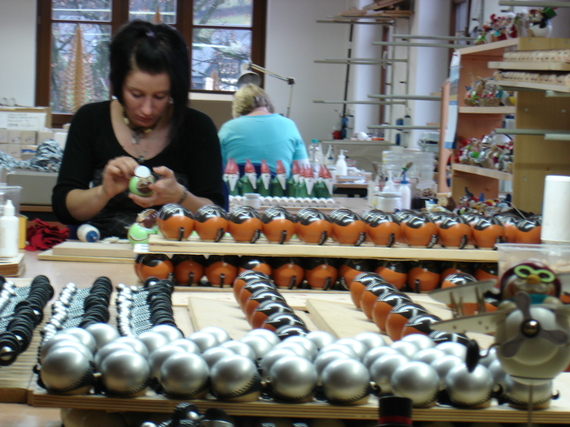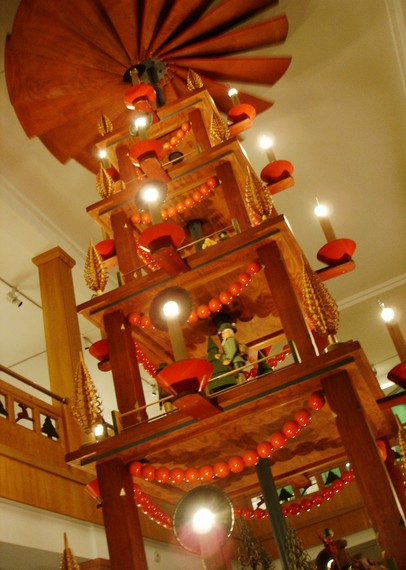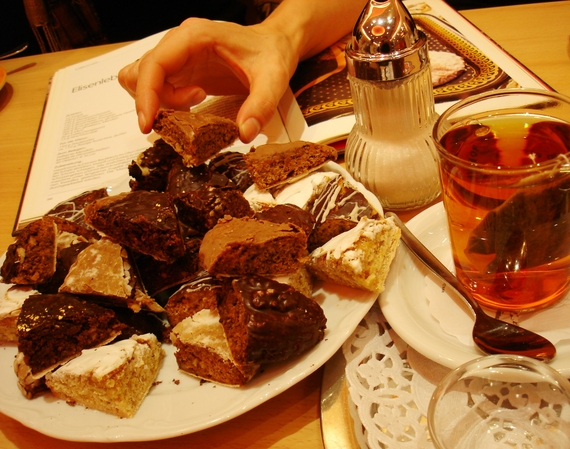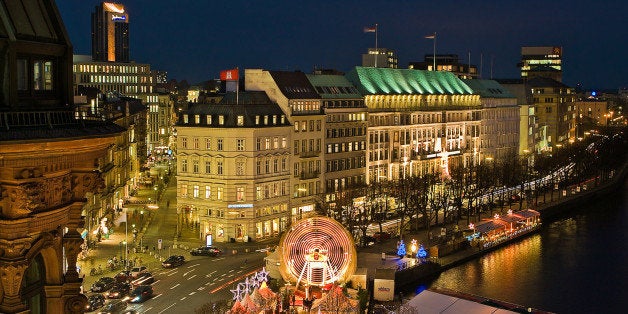
It's the geographic question of the season. When -- and exactly, where -- does Christmas begin?
Some make pilgrimages to find the first orange leaf of fall. But I am in search of December. North Pole workshops could be gearing up at this very moment. But that is secret stuff. Since I can't get a visitor's pass there, I've got a different plan.
Think early snow in Germany's Ore Mountains. The fairy-tale towns of Dresden, Bamberg and Nuremberg where open-air Christmas markets herald the holiday to come.
* * *
Historians believe the medieval tradition began in Frankfurt am Main in the late 1300s. The idea of gathering outdoors to shop for local specialties lives on in Germany and Austria and, in recent years, has been picked up elsewhere in Europe and the Americas. Sometimes called Christkindlmarkt or Weihnachtsmarkt, these annual fairs are a rare spectacle, even if you don't celebrate the holiday.
The markets debut on the first Sunday of Advent. But just before that, preparations kick into gear: Stalls for these town-square bazaars are laid out, wooden toys are carved by hand, glass is shaped for ornaments, and gingerbread (called "lebkuchen'') is being baked. I wanted a preview of the festivities. So a few weeks before Advent, I went on the hunt for mugs of hot mulled wine, the first finished nutcracker, and the earliest fresh-cut spruce to get its garland and star.
In this tradition-bound part of Germany the season was in full gear. Mountains had their first dustings of snow. Village toymakers, glassblowers, and bakers were hard at their crafts and open for touring.
The minute I arrived in Dresden, the capital of Saxony, I headed to the old town to poke around. Steeples and gables flashed with sun, showing off flourishes that had been carefully restored and painted in soft yellows, blues, and greens. It was hard to believe that this was the same city that had been firebombed during World War II, then spent decades deep in the former East Germany.
Dresden's Altmarkt square is the site of Striezelmarkt, one of the oldest Christmas markets in Germany. In a few weeks it would be a mass of bundled-up carolers and stands hawking the local Christstollen, a seasonal pastry studded with candied fruit. "Striezel'' means "stollen,'' and the market officially opens with the slicing of a giant cake.
To see how Dresden's market stollen is made, I headed for Bakery Grundmann on An der Dreikonigskirche. Frank Ludolphy, a master at this, showed me how he blends the batter. Ludolphy lost part of an index finger in his kneading machine, but it doesn't affect his dough rolling or folding of the mix into a sort of log.
"Thirty-three percent is butter,'' he boasted through an interpreter, apprentice Michael Glaeser. Glaeser sported a pigtail tucked up under his chef's cap and not one, but two braided goatees.
Although the uncooked stollen felt like Play-Doh when I tested it with my thumb, it came out of the oven magically transformed. It was lightly brown with rum-soaked raisins, nutmeg, and almonds, and tasted like a soft biscotti. I took an extra slice for the road.
In Dresden I got glimpses of history, but in Bamberg, a UNESCO World Heritage Site in northern Bavaria, I was immersed in it. I walked past houses that looked wobbly with age, and took indecisive streets that eventually led me to bridges over the Regnitz River. Bamberg is famous for its Nativity Trail, a seasonal display of about 400 Nativity scenes around town that coincides with the five local Christmas markets.
Before getting back on the road, I visited the cramped and overflowing Bamberg Nativity Museum on Obere Sandstrasse. Privately-run and open all year, this humble gallery shows off Nativity scenes from all over, including one from Central America that glowed as bright as a piñata, and an African crèche carved from exotic woods.
After more hours in the car, I made it into the mountains and under zeppelin-shaped puffs of floating mist. The air felt refrigerated, and there were stray strips of snow along the road. Out of a cloud popped the little village of Seiffen. "Maybe 3,000 people live here,'' said my guide, Anne Braun. "Maybe. But imagine: This town has more than 100 companies that make wooden toys.''
At the Erzgebirge Toy Museum in Seiffen uniformed and smiling nutcrackers stood guard over hundreds of antique boats and dolls and a Christmas windmill pyramid that, at 20 feet tall, brushed the ceiling. And at the Seiffener Volkskunst toy company, I watched traditional wood craftsmen carving out the boughs of tiny trees, gluing caps on toy soldiers, and turning bowling pins on lathes. It was like Santa's workshop, minus the elves.
Mounds of sawdust and shavings were everywhere: spruce, elder, beech, and maple. Even the aisles of the company's Christmas store smelled fresh, like an indoor forest. Early shoppers looked over complex figurines. "You don't find what you want right now?'' said Braun. "Just wait. You can see everything Seiffen makes in the Christmas markets in Dresden, in Chemnitz, all over Germany.''
In truth, I was hunting for glass. My wife loves candles and holders, so I drove to an area that is sometimes called the "cradle of Christmas'' and stopped in the town of Lauscha. It's just as miniature as Seiffen but, instead of wood, it's built on centuries of blown-glass ornaments (which were invented here), the hand-pulled rods and tubes, and the sun-hot furnaces that you need to shape them.
One of many small companies in the town, Farbglashütte Lauscha has been in business since 1853, and lets visitors take molten glass, fresh from the fire, and try blowing their own glass balls. The open doors of the furnaces reddened workers' caps and faces. One by one, they approached the 2,552-degree Fahrenheit stoves, dipped steel tongs into liquid glass, and poured it (very carefully) into a mold that, the day I was there, would make a sculpted angel.
No one wore gloves. Tinsel-like filaments of glass stretched and spilled from their tongs, cooling, then curling in beautiful spools on the concrete floor.
Angels, I realized, are born, not of clouds, but of fire.
A few days later, in Nuremberg, I talked to a real one. Rebekka Volland, 18, was the official angel of the city's Christmas market, one of the most visited in Germany.
Chosen by a jury of local leaders, Volland looked sad that her reign was nearly over. "I am like an ambassador,'' she said. "I open the market to the public. Children believe I am real. And some people think I can - what is your word? - grant their wishes.''
Is that true? I asked. "I do not think so,'' she replied.
I didn't mind. I could do without wishes. It was only November and I already had what I wanted this year: a slice of the first fruit-filled stollen of the season; a tiny, whittled tree; and a candle holder made of sea-green glass.
This year I have an inside track on Christmas. When someone strikes up "Silent Night'' or "O Tannenbaum,'' I will sing along.
But I will think of squares full of carolers and wooden stalls. I'll think of Germany's mountains and mist-dipped towns:
The place where my favorite season is made.
Peter Mandel is the author of the read-aloud bestseller Jackhammer Sam (Macmillan/Roaring Brook) and other books for kids, including Zoo Ah-Choooo (Holiday House) and Bun, Onion, Burger (Simon & Schuster).
